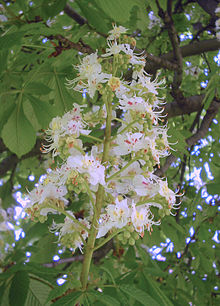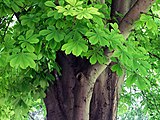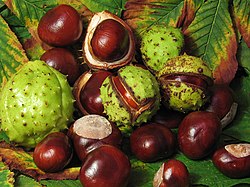
Aesculus
 |
|
| Aesculus hippocastanum |
The genus Aesculus (/ˈɛskjʊləs/[1] or /ˈaɪskjʊləs/) comprises 13–19 species of trees and shrubs native to the temperate Northern Hemisphere, with 6 species native to North America and 7–13 species native to Eurasia; there are also several hybrids. Aesculus exhibits a classical arcto-Tertiary distribution.[a] The genus has traditionally been treated in the ditypic family Hippocastanaceae along with Billia,[3] but recent phylogenetic analysis of morphological[4] and molecular data[5] has caused this family, along with the Aceraceae (Maples andDipteronia), to be included in the soapberry family (Sapindaceae).
Linnaeus named the genus Aesculus after the Roman name for an edible acorn. Common names for these trees include “buckeye” and “horse chestnut”. Some are also called white chestnut or red chestnut (as in some of the Bach flower remedies). In Britain, they are sometimes called conker trees because of their link with the game of conkers, played with the seeds, also called conkers. Aesculus seeds were traditionally eaten, after leaching, by the Jōmon people of Japan over about four millennia, until 300 AD.[6]

Aesculus glabra Ohio buckeye

Flower of Aesculus x carnea, the red Horse Chestnut
Description
Aesculus species have stout shoots with resinous, often sticky, buds; opposite, palmately divided leaves, often very large—to 65 cm (26 in) across in the Japanese horse chestnut Aesculus turbinata. The seeds of the Aesculus are traditionally used in a game called conkers in Europe. Species are deciduous or evergreen. Flowers are showy, insect- or bird-pollinated, with four or five petals fused into a lobedcorolla tube, arranged in a panicle inflorescence. Flowering starts after 80–110 growing degree days. The fruit matures to a capsule, 2–5 cm (25⁄32–1 31⁄32 in) diameter, usually globose, containing one to three seeds (often erroneously called a nut) per capsule. Capsules containing more than one seed result in flatness on one side of the seeds. The point of attachment of the seed in the capsule (hilum) shows as a large circular whitish scar. The capsule epidermis has “spines” (botanically: prickles) in some species, while other capsules are warty or smooth. At maturity, the capsule splits into three sections to release the seeds.[7][8][9]
The species of Aesculus include:
- Aesculus arguta: Aesculus glabra
- Aesculus californica: California buckeye (western North America)
- Aesculus × carnea: red horse chestnut
- Aesculus chinensis: Chinese horse chestnut (eastern Asia)
- Aesculus chinensis var. wilsonii: Wilson’s horse chestnut (eastern Asia)
- Aesculus flava (A. octandra): yellow buckeye (eastern North America)
- Aesculus glabra: Ohio buckeye (eastern North America)
- Aesculus hippocastanum: common horse chestnut (Europe, native to the Balkans)
- Aesculus indica: Indian horse chestnut (eastern Asia)
- Aesculus neglecta: dwarf buckeye (eastern North America)
- Aesculus parviflora: bottlebrush buckeye (eastern North America)
- Aesculus parryi: Parry’s buckeye (western North America, endemic in Baja California del Norte)
- Aesculus pavia: red buckeye (eastern North America)
- Aesculus pavia var. flavescens: Texas yellow buckeye, yellow woolly buckeye (eastern North America, narrowly endemic in Texas)
- Aesculus sylvatica: painted buckeye (eastern North America)
- Aesculus turbinata: Japanese horse chestnut (eastern Asia, endemic in Japan)
- Aesculus wangii: Aesculus assamica (eastern Asia)
Cultivation
The most familiar member of the genus worldwide is the common horse chestnut Aesculus hippocastanum. The yellow buckeye Aesculus flava (syn. A. octandra) is also a valuable ornamental tree with yellow flowers, but is less widely planted. Among the smaller species, the bottlebrush buckeye Aesculus parviflora also makes a very interesting and unusual flowering shrub. Several other members of the genus are used as ornamentals, and several horticultural hybrids have also been developed, most notably the red horse chestnut Aesculus × carnea, a hybrid between A. hippocastanum and A. pavia.
Use in alternative medicine
Aesculus has been listed as one of the 38 substances used to prepare Bach flower remedies,[10] a kind of alternative medicine promoted for its effect on health. However according to Cancer Research UK, “there is no scientific evidence to prove that flower remedies can control, cure or prevent any type of disease, including cancer”.[11]
References
- Jump up^ This designation has as a part of it a term, ‘Tertiary‘, that is now discouraged as a formal geochronological unit by the International Commission on Stratigraphy.[2]
- Jump up^ Sunset Western Garden Book, 1995:606–607
- Jump up^ Ogg, James G.; Gradstein, F. M; Gradstein, Felix M. (2004). A geologic time scale 2004. Cambridge, UK: Cambridge University Press.ISBN 0-521-78142-6.
- Jump up^ Hardin, JW. 1957. A revision of the American Hippocastanaceae I. Brittonia 9:145-171.
- Jump up^ Judd, WS, RW Sanders, MJ Donoghue. 1994. Angiosperm family pairs. Harvard Papers in Botany. 1:1-51.
- Jump up^ Harrington, Mark G.; Edwards, Karen J.; Johnson, Sheila A.; Chase, Mark W.; Gadek, Paul A. (Apr–Jun 2005). “Phylogenetic inference in Sapindaceae sensu lato using plastid matK and rbcL DNA sequences”. Systematic Botany 30 (2): 366–382. doi:10.1600/0363644054223549. JSTOR 25064067.
- Jump up^ Harlan, Jack R. (1995). The Living Fields: Our Agricultural Heritage (1. publ. ed.). Cambridge [u.a.]: Cambridge Univ. Press. p. 15. ISBN 0-521-40112-7.Harlan cites Akazawa, T & Aikens, CM, Prehistoric Hunter-Gathers in Japan (1986), Univ. Tokyo Press; and cites Aikens, CM & Higachi, T, Prehistory of Japan (1982), NY Academic Press.
- Jump up^ Hardin, JW. 1957. A revision of the American Hippocastanaceae I. Brittonia 9:145-171
- Jump up^ Hardin, JW. 1957. A revision of the American Hippocastanaceae II. Brittonia 9:173-195
- Jump up^ Hardin, JW. 1960. A revision of the American Hippocastanaceae V, Species of the Old World. Brittonia 12:26-38
- Jump up^ D. S. Vohra (1 June 2004). Bach Flower Remedies: A Comprehensive Study. B. Jain Publishers. p. 3. ISBN 978-81-7021-271-3. Retrieved 2 September 2013.
- Jump up^ “Flower remedies”. Cancer Research UK. Retrieved September 2013.
External links
- Germplasm Resources Information Network: Aesculus
- Forest, F., Drouin, J. N., Charest, R., Brouillet, L., & Bruneau A. (2001). A morphological phylogenetic analysis of Aesculus L. and Billia Peyr. (Sapindaceae). Canad. J. Botany79 (2): 154-169. Abstract.
- Aesculus glabra (Ohio buckeye) King’s American Dispensatory
- Winter ID pictures
Aesculus hippocastanum is a large deciduous tree, commonly known as horse-chestnut or conker tree.
Distribution
Aesculus hippocastanum is native to a small area in the Pindus Mountains mixed forests and Balkan mixed forests of South East Europe.[1]It is widely cultivated in streets and parks throughout the temperate world.
Growth
A. hippocastanum grows to 36 metres (118 ft) tall, with a domed crown of stout branches; on old trees the outer branches often pendulous with curled-up tips. The leaves are opposite and palmately compound, with 5–7 leaflets; each leaflet is 13–30 cm long, making the whole leaf up to 60 cm across, with a 7–20 cm petiole. The leaf scars left on twigs after the leaves have fallen have a distinctive horseshoe shape, complete with seven “nails”. The flowers are usually white with a small red spot; they are produced in spring in erect panicles 10–30 cm tall with about 20–50 flowers on each panicle. Usually only 1–5 fruit develop on each panicle; the shell is a green, spiky capsule containing one (rarely two or three) nut-like seeds called conkers or horse-chestnuts. Each conker is 2–4 cm diameter, glossy nut-brown with a whitish scar at the base.[2]
Etymology
The common name “horse-chestnut” (often unhyphenated) is reported as having originated from the erroneous belief that the tree was a kind of chestnut (though in fact only distantly related), together with the observation that eating the fruit cured horses of chest complaints[3] despite this plant being poisonous to horses.
Uses
Cultivation for its spectacular spring flowers is successful in a wide range of temperate climatic conditions provided summers are not too hot, with trees being grown as far north asEdmonton, Alberta, Canada,[4] the Faroe Islands,[5] Reykjavík, Iceland and Harstad, Norway.
In Britain and Ireland, the nuts are used for the popular children’s game conkers. During the First World War, there was a campaign to ask for everyone (including children) to collect horse-chestnuts and donate them to the government. The conkers were used as a source of starch for the fermentation via the Clostridium acetobutylicum method devised by Chaim Weizmann to produce acetone. Any starch plant would have done, but they chose to ask for conkers to avoid causing starvation by using food. Weizmann’s process could use any source of starch, but it was never particularly efficient and the factory only produced acetone for three months. The aim was to produce acetone for use as solvent which aided in the production of cordite, which was then used in military armaments.
The nuts, especially those that are young and fresh, are slightly poisonous, containing alkaloid saponins and glucosides. Although not dangerous to touch, they cause sickness when eaten; consumed by horses, they can cause tremors and lack of coordination.[6] Somemammals, notably deer, are able to break down the toxins and eat them safely.[citation needed]
Though the seeds are said to repel spiders there is little evidence to support these claims. The presence of saponin may repel insects but it is not clear whether this is effective on spiders.[7]
Horse-chestnuts have been threatened by the leaf-mining moth Cameraria ohridella, whose larvae feed on horse chestnut leaves. The moth was described from Macedonia where the species was discovered in 1984 but took 18 years to reach Britain.[8]
The flower is the symbol of the city of Kiev, capital of Ukraine.[9] Although the horse-chestnut is sometimes known as the buckeye, this name is generally reserved for the New World members of the Aesculus genus.
Medical uses
The seed extract standardized to around 20 percent aescin (escin) is used for its venotonic effect, vascular protection, anti-inflammatory and free radical scavenging properties.[10][11] Primary indication is chronic venous insufficiency.[11][12] A recent Cochrane Review found the evidence suggests that Horse Chestnut Seed Extract is an efficacious and safe short-term treatment for chronic venous insufficiency.[13]
Aescin reduces fluid leaks to surrounding tissue by reducing both the number and size of membrane pores in the veins.
Safety in medical use
Two preparations are considered; whole horsechestnut extract (whole HCE) and purified β-aescin. Historically, whole HCE has been used both for oral and IV routes (as of year 2001). The rate of adverse effects are low, in a large German study, 0.6%, consisting mainly of gastrointestinal symptoms. Dizziness, headache and itching have been reported. One serious safety issue is rare cases of acute anaphylactic reactions, presumably in a context of whole HCE. Purified β-aescin would be expected to have a better safety profile.
Another is the risk of acute renal failure, “when patients, who had undergone cardiac surgery were given high doses of horse chestnut extract i.v. for postoperative oedema. The phenomenon was dose dependent as no alteration in renal function was recorded with 340 μg kg−1, mild renal function impairment developed with 360 μg kg−1 and acute renal failure with 510 μg kg−1”.[14] This almost certainly took place in a context of whole HCE.
Three clinical trials were since performed to assess the effects of aescin on renal function. A total of 83 subjects were studied; 18 healthy volunteers given 10 or 20 mg iv. for 6 days, 40 in-patients with normal renal function given 10 mg iv. two times per day (except two children given 0.2 mg/kg), 12 patients with cerebral oedema and normal renal function given a massive iv. dose on the day of surgery (49.2 ± 19.3 mg) and 15.4 ± 9.4 mg daily for the following 10 days and 13 patients with impaired renal function due to glomerulonephritis or pyelonephritis, who were given 20–25 mg iv. daily for 6 days. “In all studies renal function was monitored daily resorting to the usual tests of renal function: BUN, serum creatinine, creatinine clearance, urinalysis. In a selected number of cases paraaminohippurate and labelled EDTA clearance were also measured. No signs of development of renal impairment in the patients with normal renal function or of worsening of renal function in the patients with renal impairment were recorded.” It is concluded that aescin has excellent tolerability in a clinical setting.[15]
Raw Horse Chestnut seed, leaf, bark and flower are toxic due to the presence of esculin and should not be ingested. Horse chestnut seed is classified by the FDA as an unsafe herb.[11] The glycoside and saponin constituents are considered toxic.[11]
Aesculus hippocastanum is used in Bach flower remedies. When the buds are used it is referred to as “chestnut bud” and when the flowers are used it is referred to as “white chestnut”.
Other chemicals
Quercetin 3,4′-diglucoside, a flavonol glycoside can also be found in horse chestnut seeds.[16] Leucocyanidin, leucodelphinidin and procyanidin A2 can also be found in horse chestnut.
Anne Frank Tree
A famous specimen of the horse-chestnut was the Anne Frank Tree in the centre of Amsterdam, which she mentioned in her diary and which survived until August 2010, when a heavy wind blew it over.[17][18] Eleven young specimens, sprouted from seeds from this tree, were transported to the United States. After a long quarantine in Indianapolis, each tree was shipped off to a new home at a notable museum or institution in the United States, such as the 9/11 Memorial Park, Central H.S. in Little Rock, and two Holocaust Centers. One of them was planted outdoors in March 2013 in front of the Children’s Museum of Indianapolis, where they were originally quarantined. [1]
Bonsai
The horse-chestnut is a favourite subject for bonsai.[19]
Diseases
- Bleeding Canker. Half of all horse-chestnuts in Great Britain are now showing symptoms to some degree of this potentially lethal bacterial infection.[20][21]
- Guignardia leaf blotch, caused by the fungus Guignardia aesculi
- Wood rotting fungi, e.g. such as Armillaria and Ganoderma
- Horse-chestnut scale, caused by the insect Pulvinaria regalis
- Horse-chestnut leaf miner, Cameraria ohridella, a leaf mining moth.[22] also affecting large numbers of UK trees.[21]
- Phytophthora bleeding canker, a fungal infection.[23]
| Name | Language | First published | Last updated |
|---|---|---|---|
| Final Community herbal monograph on Aesculus hippocastanum L., cortex | (English only) | 27/06/2012 | |
| Opinion of theHMPC on a Community herbal monograph on Aesculus hippocastanum L., cortex | (English only) | 27/06/2012 | |
| Final assessment report on Aesculus hippocastanum L., cortex | (English only) | 27/06/2012 | |
| Final list of references supporting the assessment of Aesculus hippocastanum L., cortex | (English only) | 27/06/2012 | |
| Overview of comments received onCommunity herbal monograph on Aesculus hippocastanum L., cortex |
| Draft Community herbal monograph on Aesculus hippocastanum L., cortex | (English only) | 26/10/2011 | |
| Draft assessment report on Aesculus hippocastanum L., cortex | (English only) | 26/10/2011 | |
| Draft list of references supporting the assessment of Aesculus hippocastanum L., cortex | (English only) | 26/10/2011 | |
| Procedure for calls for scientific data for use in HMPCassessment work |
| Latin name of the genus | Aesculus |
|---|---|
| Latin name of herbal substance | Hippocastani cortex |
| Botanical name of plant | Aesculus hippocastanum L. |
| English common name of herbal substance | Horse-chestnut bark |
| Status | F: Assessment finalised |
| Date added to the inventory | 06/05/2010 |
| Date added to priority list | 06/05/2010 |
| Outcome of European assessment | Community herbal monograph |
| Latin name of the genus | Aesculus |
|---|---|
| Latin name of herbal substance | Hippocastani semen |
| Botanical name of plant | Aesculus hippocastanum L. |
| English common name of herbal substance | Horse-Chestnut Seed |
| Status | F: Assessment finalised |
| Date added to the inventory | 07/09/2006 |
| Date added to priority list | 07/09/2006 |
| Outcome of European assessment | Community herbal monograph |
| Name | Language | First published | Last updated |
|---|---|---|---|
| Final community herbal monograph on Aesculus hippocastanum L., semen | (English only) | 16/07/2009 | |
| Opinion of the Committee on Herbal Medicinal products on a community herbal monograph on Aesculus Hippocastanum L., semen | (English only) | 16/07/2009 | |
| Final list of references for assessment of: Hippocastani semen Aesculus hippocastanum L., semen (horse chestnut seed) | (English only) | 16/07/2009 | |
| Assessment report on Aesculus hippocastanum L., semen | (English only) | 16/07/2009 | |
| Overview of comments received on community herbal monograph on Aesculus hippocastanum L., semen (EMEA/HMPC/225319/2008) | (E |




















Sorry, the comment form is closed at this time.